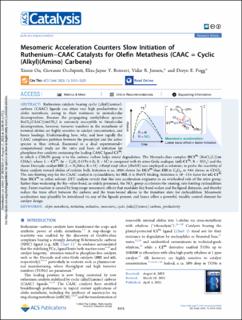| dc.description.abstract | Ruthenium catalysts bearing cyclic (alkyl)(amino)carbene (CAAC) ligands can attain very high productivities in olefin metathesis, owing to their resistance to unimolecular decomposition. Because the propagating methylidene species RuCl2(CAAC)(═CH2) is extremely susceptible to bimolecular decomposition, however, turnover numbers in the metathesis of terminal olefins are highly sensitive to catalyst concentration, and hence loadings. Understanding how, why, and how rapidly the CAAC complexes partition between the precatalyst and the active species is thus critical. Examined in a dual experimental–computational study are the rates and basis of initiation for phosphine-free catalysts containing the leading CAAC ligand C1Ph, in which a CMePh group α to the carbene carbon helps retard degradation. The Hoveyda-class complex HC1Ph (RuCl2(L)(═CHAr), where L = C1Ph, Ar = C6H3-2-OiPr-5-R; R = H) is compared with its nitro-Grela analogue (nG-C1Ph; R = NO2) and the classic Hoveyda catalyst HII (L = H2IMes; R = H). t-Butyl vinyl ether (tBuVE) was employed as substrate, to probe the reactivity of these catalysts toward olefins of realistic bulk. Initiation is ca. 100× slower for HC1Ph than HII in C6D6, or 44× slower in CDCl3. The rate-limiting step for the CAAC catalyst is cycloaddition; for HII, it is tBuVE binding. Initiation is 10–13× faster for nG-C1Ph than HC1Ph in either solvent. DFT analysis reveals that this rate acceleration originates in an overlooked role of the nitro group. Rather than weakening the Ru–ether bond, as widely presumed, the NO2 group accelerates the ensuing, rate-limiting cycloaddition step. Faster reaction is caused by long-range mesomeric effects that modulate key bond orders and Ru-ligand distances, and thereby reduce the trans effect between the carbene and the trans-bound alkene in the transition state for cycloaddition. Mesomeric acceleration may plausibly be introduced via any of the ligands present, and hence offers a powerful, tunable control element for catalyst design. | en_US |

